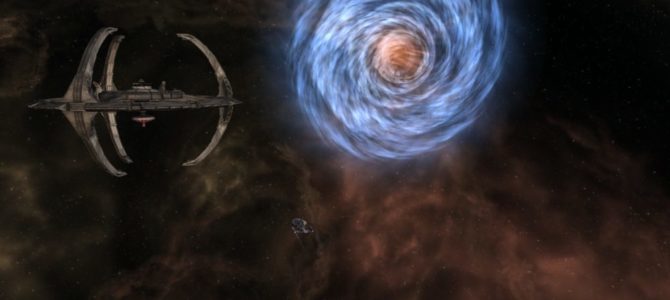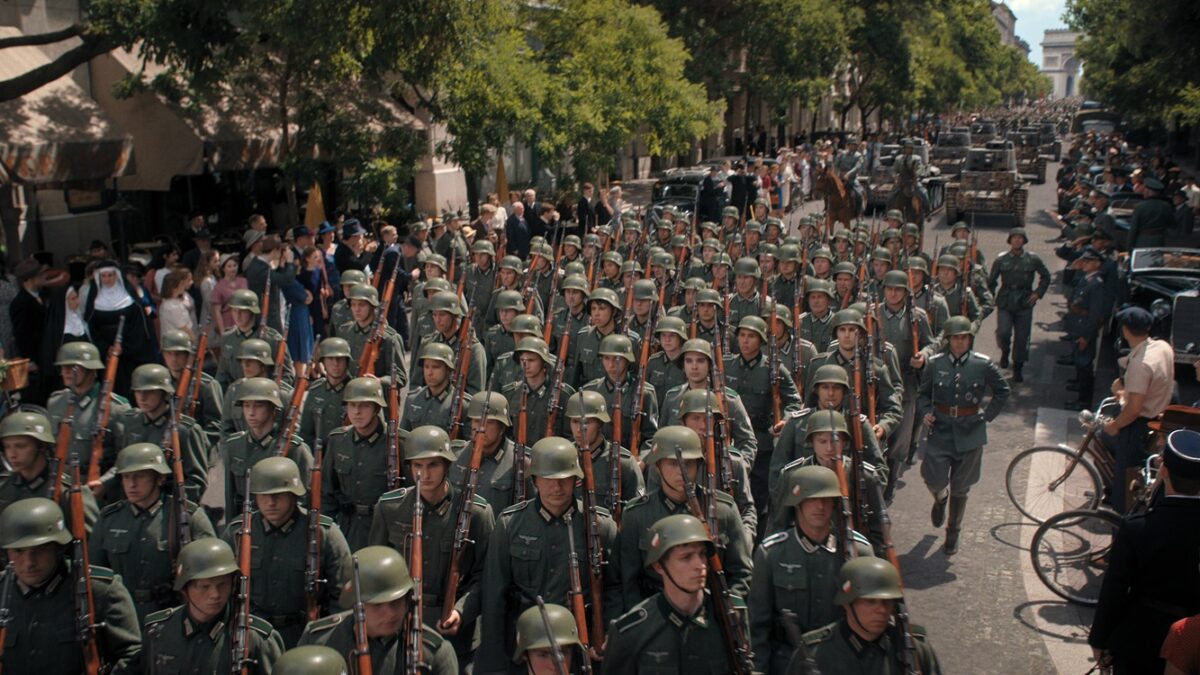
The United Federation of Planets at times resembles a 24th Century British Empire. They profess to want to acquire no territory, yet always manage to expand and find themselves rubbing up against the other galactic powers. Like British explorer David Livingstone, the Federation explores the galaxy benevolently — any annexations are purely incidental.
Livingstone was also a missionary and an abolitionist and his famous formulation of the aim of his career — spreading “Christianity, Commerce, and Civilization” — was as admired in his time as it is reviled today. The Federation has no religion, but the spread of the last two of the three C’s still fit the human-dominated organization’s mission. The “commerce” part of that, as discussed last time, is confusing, since Roddenberry’s Federation contains no monetary system to speak of (unless the plot of an episode demands it) while the non-Federation aliens (especially the Ferengi) trade with each other constantly.
In Episode 2 of Deep Space Nine’s first season, “A Man Alone,” we see the third C, Civilization, come to the fore. Unlike many in episodes to come, here the Federation’s high-minded devotion to abstract principles and ideals actually works to the benefit of the multi-ethnic space station. (This episode is listed second on Netflix and is second in order of production codes, but was actually the third to air.)
The episode’s main plot was essentially a murder mystery. While at Quark’s, Odo spies an old enemy across the room: Ibudan (Stephen James Carver) a Bajoran smuggler with whom Odo had tangled during the occupation. Ibudan was considered a hero by many on Bajor for smuggling in medical supplies to the oppressed populace, but his price gouging offended Odo’s sense of justice. Ibudan was jailed by the Cardassians for murdering an occupation soldier and freed after Bajor’s independence.
Ibudan and Odo immediately tangle at Quark’s and the altercation turns physical. Odo plans to expel him from the station but Sisko insists that without any crime being proved against the man, they can take no action. When he worked for the Cardassians, his job was to impose order and justice, and how he happened to arrive at that end result was unimportant. This is Odo’s first encounter with the Federation’s idea of due process of law, and he doesn’t like it.
The next day, Ibudan is dead. After their public altercation, Odo is the prime suspect but is also, for the moment, in charge of the investigation. He goes about his business with the dispassionate attitude that will become his hallmark, but Ibudan’s Bajoran friends become increasingly angry at the situation, wondering where Odo’s loyalties lie, given his past employment by the Cardassians. While the station’s Federation doctor, Julian Bashir (Alexander Siddig) discovers some unusual biological evidence in Ibudan’s quarters, the Bajorans form a lynch mob outside Odo’s office. (And, speaking of British colonialism: Siddig is the descendant of Muhammad Ahmad, the 19th Century Sudanese religious leader who proclaimed himself the Mahdi and started a rebellion against British rule in 1881.)
Sisko fires a phaser into the air (the second episode he has done so) and tells them to disburse, that they will do no murder that day. Odo is saved, but temporarily removed from the case. Again, the Federation rule of law intervenes in the once-lawless station. Bashir works with Dax to investigate the evidence he uncovered and discerns that it is the beginnings of a clone of Ibudan. As the new clone grows in a vat, the crew realizes that the body they found in the holosuite was also a clone — killed by Ibudan himself.
Odo tracks down a Bajoran cleric we have seen lurking throughout the episode and unmasks him Scooby-Doo-style to reveal Ibudan, alive and well. Odo arrests his old enemy for the murder of his own clone and is restored to his post as constable. Order is restored, with a bit more law to back it up.
The B-plot of the episode also focuses on the Federation’s civilizing influence at Deep Space Nine. Early in the show, Sisko and Dax witness an argument between O’Brien and his wife, Keiko; this will become fairly common in the series. Keiko O’Brien (women still take their husbands’ last names in the twenty-fourth century) was the ship’s botanist when the pair served aboard the Enterprise, but on Deep Space Nine she has no job and, she feels, no purpose. Miles suggests growing some trees on the station’s promenade, but even he can see this is not going to wash.
Meanwhile, Jake and Nog pull pranks and get into mischief together around the station. Keiko realizes that the boys, like all the children on the station, have nothing to do but get into trouble because there is no school. She proposes to Sisko that she start one. He agrees and says he will enroll his son, but warns her that it will be a challenge to find a curriculum that will satisfy all of the alien cultures represented on the station.
Keiko tries to convince Rom (Max Grodénchik,) Nog’s father, to send his son to school. Rom refuses, saying that Ferengi children learn by being tossed into the marketplace to sink or swim and that, regardless, Nog would never listen to a woman (the Ferengi are Star Trek’s most capitalist and most misogynist species). But Keiko suggests that a Federation-style education might give Nog a competitive advantage someday by teaching him how other cultures think. In the end, Rom acquiesces and the two boys start school together, along with a few other kids.
Mixed in with all this is an exploration of the old friendship between Sisko and Dax. Dax is a member of what the show’s writers called a joined species, with one creature living within another’s body. The “parasitic” being is a slug-like thing with an extremely long lifespan and the “host” is the humanoid creature with a human-like lifespan. The joined creature has a mix of the two personalities and carries the memories of past hosts into new ones.
When Sisko first knew Dax (the symbiont) he was joined with an old man (Curzon). Curzon-Dax was, in Sisko’s words, a second father to him and a mentor with whom he developed a deep friendship. Dax’s new host is Jadzia, a beautiful young woman played by model-actress Terry Farrell. Sisko is eager to renew acquaintances with his old friend, but Jadzia-Dax warns that sometimes friendships don’t survive the transition from one host to another.
As Sisko stumbles over pronouns, there is a comparison to the present-day issues of transgender people for those who care to draw it, but in 1993 it was unlikely to have been on the writers’ minds. It is, though, an exploration of the ideas of friendship, consciousness, and gender that makes for a rich source of plot material.
We also see, as we did in the series premiere, the unflagging effort by Bashir to get Dax to date him. She seems completely unperturbed by his laddish efforts, having seen it all in her 300-plus years. Sisko warns Bashir not to bother but also makes clear that he is not, himself, interested in a romantic relationship with the person he last knew as an old man and father figure. While much of the show still seems fresh, Bashir’s role as the Sam Malone/Barney Stinson-type horndog feels outdated in the current era of sensitivity over such matters.
That aside, both of the episode’s outcomes are victories for the Federation’s way of life. In this instance, they reflect some of the better segments of Roddenberry’s utopian vision: education and the rule of law. These are more readily appreciated by the average viewer than Roddenberry’s other madcap ideas, and again showcase why Deep Space Nine is the most human and most engaging show in the Star Trek universe.









